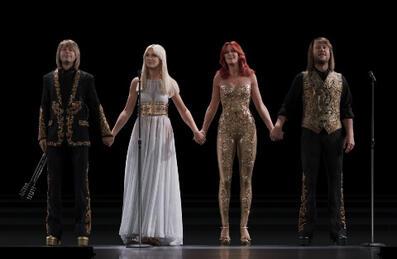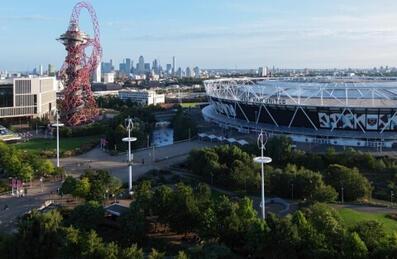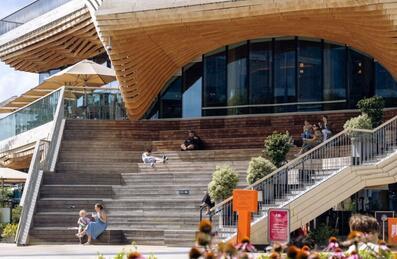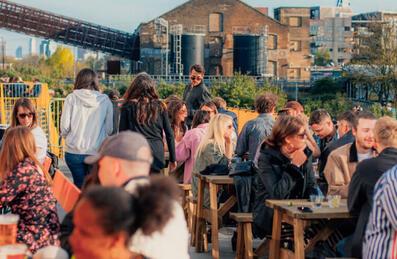
Popular Searches:
Keep up to date
Sign up today for exclusive offers and incredible experiences you won’t want to miss at Queen Elizabeth Olympic Park.
Sign up now‘PLASTIC FANTASTIC’ AND ‘REDGRAVIA’ AMONG SUGGESTIONS FOR THE PARK’S FUTURE NEIGHBOURHOODS
‘PLASTIC FANTASTIC’ AND ‘REDGRAVIA’ AMONG SUGGESTIONS FOR THE PARK’S FUTURE NEIGHBOURHOODS
Press Release 12/04/2011
The Olympic Park Legacy Company has received a fantastic response to the launch of its‘Your Park, Your Place’ competition, which gives people the chance to leave their mark in East London’s history.
So far, almost 1,000 suggestions have been received through this website on
the competition page, which features an interactive map with descriptions of how the areas will look, along with historical information, to give people a feel for the new neighbourhoods and help generate ideas for names.
The Legacy Company is offering a tour of the Olympic Park as a prize for the 1,000th and 1,500th entry so people can see first hand where the neighbourhoods will be developed over the next 20 years.
People have until Wednesday 18th May 2011 to make their suggestions and give the reasons behind them.
Andrew Altman, Chief Executive of the Olympic Park Legacy Company, said:
“We have had an incredible response to our competition. ‘Your Park, Your Place’ has captured the imagination of people of all ages from across the UK, and provoked some really inventive thinking and fascinating stories.
“But we want more. This is your chance to shape London’s history. Whether it’s a name connected to the rich history of the area or a connection to London life, we want to hear from you.”
The suggestions so far include:
Area 1 (North-East of Park)
- Hoy Gateway – named after Chris Hoy as it is near the Velodrome
- Cosmopolitan Park – because London is a colourful, multi-cultural, diverse city
- Liddell Quarter – Eric Liddell personified Olympic ideals by the way he lived and competed and this is documented in the film ‘Chariots of Fire’. The name ‘Liddell Quarter’ is reminiscent of the quarter mile, a distance he ran as an alternative to the 400m. His life came to an end in a Japanese Prison Camp in China – the existence of pill-boxes in Area 1 is a concrete reminder of the War
- Redgravia – a mixture of Belgravia and London and Sir Steve Redgrave
- Angelplace – the loveliest street in Stratford was Angel Lane until it was demolished in the 70s. It had lovely Victorian shops as it ran from St John’s Church up to the Theatre Royal.
Area 2 (North-West)
- Plastic Fantastic or Plasticity – due to the area’s heritage as a plastics works
- Templar Mills – Temple Mills were water mills belonging to the Knights Templar, used mainly for grinding corn from extensive lands in Homerton and the Marshes
- Dog and Bike – after the greyhound and motorbike track
- The Cut – the area between the canals used to be referred to as The Cut where I used to swim and fish as a boy
- Speedy Danes – because Danes invaded the area and there used to be a dog track.
Area 3 (South-West)
- Olympic Park Hill – the highest natural point on the Olympic Park development
- The Sweets – named after the confectionery factory based in the area
- Altius – from the Olympic motto ‘Citius, Altius, Fortius’ – Altius means higher. This is the highest natural point in the Park
- Populas – Latin for people and named after the great people of the area
- Petropolis – as the term petrol was coined here and it is part of a great metropolis.
Area 4 (South-East)
- Little Athens – birthplace of the Olympics and a waterside theme
- Flying Scotsman – after the locomotive which used Stratford as a base for many years. Also the epithet applies to Eric Liddell, as featured in ‘Chariots of Fire’ and more recent Olympians such as Chris Hoy
- The Sidings – when I worked in the area in the 1970’s it was referred to as The Sidings
- The Rings – Olympic significance especially with the area dominated by the main stadiums
- Freshwater Village – because the village has connections to water through the past in Pudding Mill and City Mill rivers, and today through the Aquatics Centre and riverside setting
- Lavender Lane – because the old Yardley factory which manufactured perfumes and cosmetics was in the area.
Area 5 (South)
- Poseidon – named after the Greek God of the sea
- Henry Croft Park – named after the founder of the Pearly Kings and Queens
- Lea Fields – named after the proximity to the River Lea and a planned new school
- East Metropolis – the fleet of engineering on the Olympic Park is beyond belief. There is a sense of the Park being somewhat like a world within a world
- Winalbion Cross – the name links the ancient Roman name for England ‘Albion’ while ‘Cross’ links with the ancient causeways and the integral crossing aspect of the area. ‘Win’ illustrates the impact of water across the area and its proximity with the Bow Back rivers, River Lea and her waterways.
Entries will be judged by a panel including representatives from the neighbouring Olympic host boroughs, local residents, Government, the Museum of London Archaeology Service and the Olympic Park Legacy Company.
They will select the name for each of the neighbourhoods from the entries based on factors including popularity, historical referencing and their relation to the area’s diverse communities.
The Legacy Company is encouraging local schools to take part in the competition, along with local community centres, faith centres and sports centres.
Earlier this month, the Legacy Company announced the upcoming opportunity for developers to build the first of the five new neighbourhoods which will sit between the VeloPark and the Athletes Village in the north-east of the Park. The neighbourhood will be centred around 800 new homes and 3,000 sq m of community and ancillary facilities including a polyclinic, two nurseries and a community centre.
The other four neighbourhoods will be in the north-west of the Park, next to Hackney Wick; in the south-west, in and around the Old Ford area; between Stratford City and the Stadium; and to the south-east of the Stadium, near Pudding Mill Station; see /competition/
They will accommodate up to 8,000 new homes, supported by a network of new schools, nurseries, health centres and community spaces, sitting alongside the sporting venues, 6.5km of waterways, cultural attractions and open spaces.
The homes will combine tradition and innovation with the development including modern versions of London’s traditional Georgian and Victorian squares and terraces, as well as riverside properties. Up to 35% of them will be affordable housing, in-line with the Mayor’s London Plan.
The five new neighbourhoods will open in phases to the public from 2013, with families moving into the first new homes in 2015.






